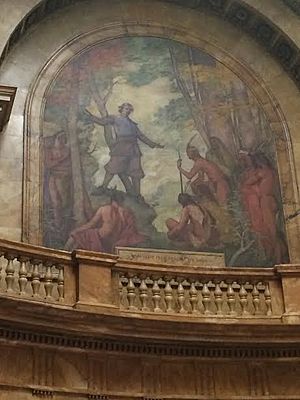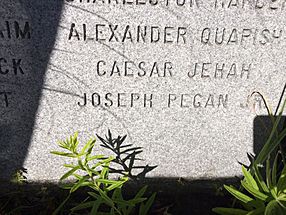Praying Indian facts for kids
Praying Indian is a term from the 1600s. It describes Native Americans in places like New England, New York, Ontario, and Quebec. These were people who chose to become Christian, or sometimes were forced to. Many groups were called "Praying Indians." But the term is most often used for tribes that lived in special villages. These villages were known as praying towns. Missionaries like the Puritan leader John Eliot and Jesuit missionaries started these towns. They also set up missions among the Huron people in western Ontario.
Contents
Early History of Praying Towns

In 1646, the General Court of Massachusetts passed a law. It was called the "Act for the Propagation of the Gospel amongst the Indians." This law, and the success of Reverend John Eliot and other missionaries, made people in England interested. These missionaries were teaching Christianity to New England tribes. In 1649, the Long Parliament created a group. It was called "A Corporation for the Promoting and Propagating the Gospel of Jesus Christ in New England." This group raised money to help the cause.
People gave about £12,000 to support this work. Most of the money was used in the Massachusetts Bay Colony and New York. John Eliot got money from this group to start schools for Native Americans. The Native nations involved included the Massachusett and the Nipmuc people.
On October 28, 1646, in Nonantum (now Newton), Eliot gave his first sermon to Native Americans. He spoke in their Massachusett language inside a wigwam. Waban was the first person from his tribe to convert. Waban later offered his son to be taught European ways. He also worked as an interpreter. Eliot translated the Bible into the Massachusett language. It was published in 1663 as the Mamusse Wunneetupanatamwe Up-Biblum God. By 1675, 20% of New England's Native people lived in Praying Towns.
Christian Indian Towns were set up across Eastern and Central Massachusetts. Some towns included Littleton (Nashoba) and Lowell (Wamesit). Others were Grafton (Hassanamessit) and Marlborough (Okommakamesit). There was also Hopkinton (Makunkokoag) and Canton (Punkapoag). Mendon-Uxbridge (Wacentug) and Natick were also praying towns. Only Natick still has its original name. Eliot's Praying Indian Towns also reached into Connecticut. One was Wabaquasset (Senexet, Wabiquisset) in present-day Woodstock.
These towns also helped defend the colony. But this role ended in 1675, during King Philip's War. Praying Indians offered to be scouts for the colonists. But the Puritans in Boston said no. Instead, Praying Indian residents were kept in their villages. This meant they could not reach their farms. They could not get food for themselves. Many were sent to Deer Island in Boston Harbor.
John Eliot and others tried to stop this. But it became dangerous to speak positively about Native Americans in Massachusetts. This likely helped the Native rebellion succeed. The order to remove them was passed in October 1675. By December, over 1,000 Christian Indians were on the island. Many died during the winter because of the harsh conditions. The survivors were released in 1676.
After the war, many people had died. So, the General Court of Massachusetts closed 10 of the original 14 towns in 1677. The remaining towns were put under the watch of colonists. But some communities survived. They kept their religious and education systems.
Land Dispute in Dedham
In the mid-1600s, Reverend John Eliot and a group of Praying Indians from Dedham, Massachusetts won a long court case. They were given ownership of 2,000 acres of land. This land is now known as Natick.
The argument lasted from 1651 to 1665. It even came up again later. It was about the Indians using land along the Charles River. They said they had an agreement with the town leaders to use the land for farming. But Dedham officials did not agree.
Eliot had helped many Native people in the area become Christian. He taught them how to live a settled farming life. So many converted that the group needed a large area of land for their crops. The law was on the side of the town. But Eliot argued that the group needed their own land.
The case went to the General Court. The court gave the land to the Native Americans. To make up for the lost land, Dedham settlers were given another piece of land. This land is now Deerfield, Massachusetts. The town of Dedham acted unfairly in this case. They made false accusations against their Native neighbors even after the issue was settled.
Praying Indians in the American Revolutionary War
Many stories about Native American history are not well known. A large number of Praying Indians fought for the Continental Army during the Revolutionary War. By this time, most of these Indians had become part of their Christian communities. They had fewer strong ties to other Native groups. They fought in units that included both Native and non-Native soldiers. This was different from African-American soldiers, who fought in separate units for a long time.
There is no sign that Native American soldiers were treated unfairly. They received the same pay and treatment as white soldiers. This is different from the Civil War, for example. In that war, African-American soldiers fought in separate units. They were also paid less at first. Soldiers of Native American origin fought in important battles. These included Bunker Hill, Battle Road, Trenton, and Saratoga. More than 100 Praying Indian soldiers likely fought. But an exact count is hard to find.
Other Native groups, like the Iroquois Confederacy, were divided. But the Praying Indians were united. They strongly supported the colonists. The Iroquois Confederacy had different groups. Most supported the British during the Revolutionary War. But some fought with the colonists. This led to fights between groups that used to be allies. For example, at the Battle of Oriskany in 1777, Loyalist Seneca soldiers fought against Oneidas who supported the colonists.
The Praying Indians never split like this. They had very close ties to the Puritan leaders who started the Praying towns. They also had close ties to non-Native people living among them. Even though Native lands were still being taken, the Praying Indian communities knew something important. They knew their survival depended on strong ties to their local communities. Supporting a faraway government would only make them outsiders to their neighbors.
Praying Indians from Natick and Ponkapoag (now Canton) served in large numbers. The borders of Natick have changed since then. It now includes parts of what used to be Needham and Dedham.
The first big battles Praying Indians fought in were Battle Road and Bunker Hill. About five of the 21 Native Americans at Battle Road were from Praying Indian communities. About 10 of the 103 Native Americans at Bunker Hill were Praying Indians from the Natick area. Because units were mixed, there was usually no large group of Praying Indians in one unit. Praying Indians served in many different units during the war. The Battle of King's Bridge in the Bronx was an exception. There, Daniel Nimham and his son Abraham were killed. About 60 members of the Stockbridge Militia also died.
Soldiers of Praying Indian Origin
Historian George Quintal Jr. wrote about Revolutionary War veterans. His book Patriots of Color talks about Native American, African-American, and other minority soldiers. Here are some examples of Praying Indian soldiers.
James Anthony was born in Natick. He first served for eight months in 1775. He was in Col. Jonathan Ward's regiment. He later joined again for three years, from 1777 to 1780. He was in the 4th Massachusetts Regiment. His unit fought at Saratoga. They were also at Valley Forge during the winter of 1777. Anthony left the army in March 1780.
Joseph Paugenit Jr. (Mashpee Wampanoag) was born in Framingham. He was baptized in Natick in 1754. His father, Joseph Sr., fought in the French and Indian War. Joseph Jr. fought at Bunker Hill. He later joined again and fought in New York. He was at the Battles of Harlem Heights and White Plains. He joined a third time. He fought at the Battle of Saratoga. He was reported dead soon after. This was likely from battle wounds or smallpox.
Alexander Quapish (Wampanoag, 1741–1776) was born in Wampanoag territory in Yarmouth, Massachusetts. He joined the army in Dedham in 1775. He was in the 13th Massachusetts Regiment. He became sick in November 1775. He died in Needham in March 1776. Michael Bacon cared for him and buried him. Quapish's remains were later moved. They were given to the Warren Anatomical Museum. Under NAGPRA, the Mashpee Wampanoag and Nipmuc Nation were able to get his remains back. They were returned to the Pond Street Burial Ground in Needham (now Natick).
Samuel Comecho fought at the Battle of Bunker Hill. He was born in Natick. Comecho joined for eight months. His unit held the line at Bunker Hill. He joined again in 1776. He served in the Canadian area. It was reported that he died on March 14, 1776. The cause of death was likely smallpox.
Legacy of Service
The sacrifices made by Praying Indians and other minority groups during the Revolutionary War have not always been fully recognized. It was not until the 1900s that these veterans were first honored. The town of Natick put up a monument to Native American veterans in 1900. It still stands today on Pond Street. But it was Needham historian Robert D. Hall Jr. who properly honored their burial places. In 2003, Hall and volunteers placed grave markers and American flags in a Needham cemetery.
Self-Government and Changes
The Praying Indian communities could govern themselves. They could elect their own leaders, called sachems, and other officials. This showed some connection to their old social system before Europeans arrived. They also used their own language for official documents. Many of these documents still exist. However, their self-government slowly decreased in the 1700s and 1800s. Their languages also died out around this time. During this period, most of the original "Praying Towns" declined. This was due to diseases and their shared land being taken by others. The areas where Indians lived eventually became "Indian districts."

Praying Indians Today
Descendants of the Praying Indians from Natick have formed a group. It is called the Praying Indian Tribe of Natick. The current leader is Rosita Andrews, also known as Caring Hands. She lives in Stoughton, Massachusetts. She received her title of chief from her mother. The Praying Indian members live within 20 miles of Stoughton. According to Caring Hands, in 2011, there were just under 50 members of Natick Praying Indians. On August 11, 2012, members of the tribe held a public service. It was at Eliot Church in South Natick. This was the site of the original church of the Praying Indian town of Natick. It was the first time they held a service there in almost 300 years.



